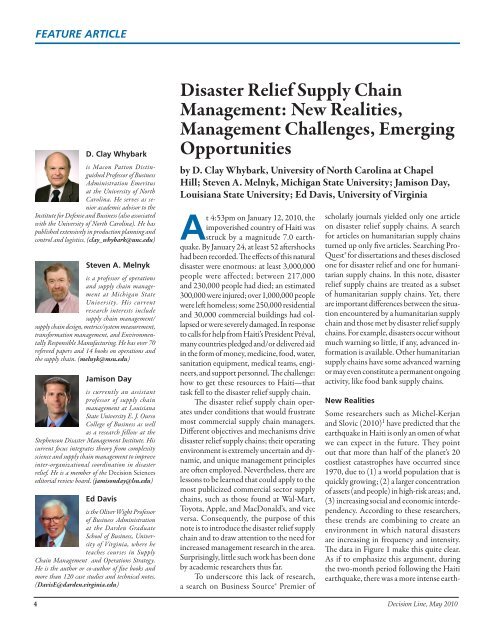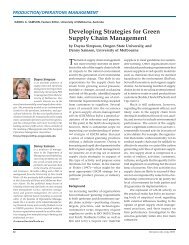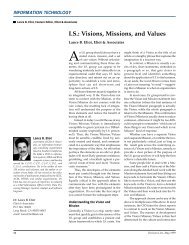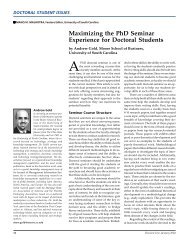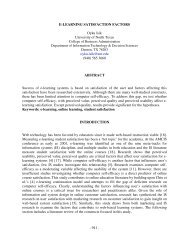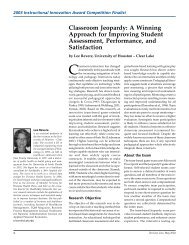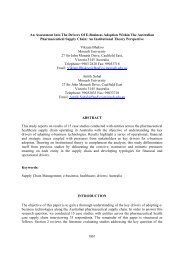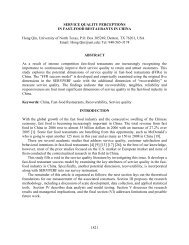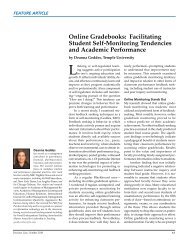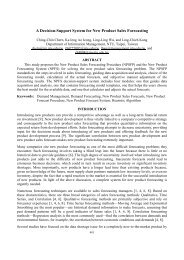Disaster Relief Supply Chain Management: New Realities ...
Disaster Relief Supply Chain Management: New Realities ...
Disaster Relief Supply Chain Management: New Realities ...
You also want an ePaper? Increase the reach of your titles
YUMPU automatically turns print PDFs into web optimized ePapers that Google loves.
FEATURE ARTICLE<br />
D. Clay Whybark<br />
is Macon Patton Distinguished<br />
Professor of Business<br />
Administration Emeritus<br />
at the University of North<br />
Carolina. He serves as senior<br />
academic advisor to the<br />
Institute for Defense and Business (also associated<br />
with the University of North Carolina). He has<br />
published extensively in production planning and<br />
control and logistics. (clay_whybark@unc.edu)<br />
Steven A. Melnyk<br />
is a professor of operations<br />
and supply chain management<br />
at Michigan State<br />
University. His current<br />
research interests include<br />
supply chain management/<br />
supply chain design, metrics/system measurement,<br />
transformation management, and Environmentally<br />
Responsible Manufacturing. He has over 70<br />
refereed papers and 14 books on operations and<br />
the supply chain. (melnyk@msu.edu)<br />
Jamison Day<br />
is currently an assistant<br />
professor of supply chain<br />
management at Louisiana<br />
State University E. J. Ourso<br />
College of Business as well<br />
as a research fellow at the<br />
Stephenson <strong>Disaster</strong> <strong>Management</strong> Institute. His<br />
current focus integrates theory from complexity<br />
science and supply chain management to improve<br />
inter-organizational coordination in disaster<br />
relief. He is a member of the Decision Sciences<br />
editorial review board. (jamisonday@lsu.edu)<br />
Ed Davis<br />
is the Oliver Wight Professor<br />
of Business Administration<br />
at the Darden Graduate<br />
School of Business, University<br />
of Virginia, where he<br />
teaches courses in <strong>Supply</strong><br />
<strong>Chain</strong> <strong>Management</strong> and Operations Strategy.<br />
He is the author or co-author of five books and<br />
more than 120 case studies and technical notes.<br />
(DavisE@darden.virginia.edu)<br />
<strong>Disaster</strong> <strong>Relief</strong> <strong>Supply</strong> <strong>Chain</strong><br />
<strong>Management</strong>: <strong>New</strong> <strong>Realities</strong>,<br />
<strong>Management</strong> Challenges, Emerging<br />
Opportunities<br />
by D. Clay Whybark, University of North Carolina at Chapel<br />
Hill; Steven A. Melnyk, Michigan State University; Jamison Day,<br />
Louisiana State University; Ed Davis, University of Virginia<br />
At 4:53pm on January 12, 2010, the<br />
impoverished country of Haiti was<br />
struck by a magnitude 7.0 earthquake.<br />
By January 24, at least 52 aftershocks<br />
had been recorded. The effects of this natural<br />
disaster were enormous: at least 3,000,000<br />
people were affected; between 217,000<br />
and 230,000 people had died; an estimated<br />
300,000 were injured; over 1,000,000 people<br />
were left homeless; some 250,000 residential<br />
and 30,000 commercial buildings had collapsed<br />
or were severely damaged. In response<br />
to calls for help from Haiti’s President Préval,<br />
many countries pledged and/or delivered aid<br />
in the form of money, medicine, food, water,<br />
sanitation equipment, medical teams, engineers,<br />
and support personnel. The challenge:<br />
how to get these resources to Haiti—that<br />
task fell to the disaster relief supply chain.<br />
The disaster relief supply chain operates<br />
under conditions that would frustrate<br />
most commercial supply chain managers.<br />
Different objectives and mechanisms drive<br />
disaster relief supply chains; their operating<br />
environment is extremely uncertain and dynamic,<br />
and unique management principles<br />
are often employed. Nevertheless, there are<br />
lessons to be learned that could apply to the<br />
most publicized commercial sector supply<br />
chains, such as those found at Wal-Mart,<br />
Toyota, Apple, and MacDonald’s, and vice<br />
versa. Consequently, the purpose of this<br />
note is to introduce the disaster relief supply<br />
chain and to draw attention to the need for<br />
increased management research in the area.<br />
Surprisingly, little such work has been done<br />
by academic researchers thus far.<br />
To underscore this lack of research,<br />
a search on Business Source® Premier of<br />
scholarly journals yielded only one article<br />
on disaster relief supply chains. A search<br />
for articles on humanitarian supply chains<br />
turned up only five articles. Searching Pro-<br />
Quest® for dissertations and theses disclosed<br />
one for disaster relief and one for humanitarian<br />
supply chains. In this note, disaster<br />
relief supply chains are treated as a subset<br />
of humanitarian supply chains. Yet, there<br />
are important differences between the situation<br />
encountered by a humanitarian supply<br />
chain and those met by disaster relief supply<br />
chains. For example, disasters occur without<br />
much warning so little, if any, advanced information<br />
is available. Other humanitarian<br />
supply chains have some advanced warning<br />
or may even constitute a permanent ongoing<br />
activity, like food bank supply chains.<br />
<strong>New</strong> <strong>Realities</strong><br />
Some researchers such as Michel-Kerjan<br />
and Slovic (2010) 1 have predicted that the<br />
earthquake in Haiti is only an omen of what<br />
we can expect in the future. They point<br />
out that more than half of the planet’s 20<br />
costliest catastrophes have occurred since<br />
1970, due to (1) a world population that is<br />
quickly growing; (2) a larger concentration<br />
of assets (and people) in high-risk areas; and,<br />
(3) increasing social and economic interdependency.<br />
According to these researchers,<br />
these trends are combining to create an<br />
environment in which natural disasters<br />
are increasing in frequency and intensity.<br />
The data in Figure 1 make this quite clear.<br />
As if to emphasize this argument, during<br />
the two-month period following the Haiti<br />
earthquake, there was a more intense earth-<br />
4 Decision Line, May 2010
quake in Chile, and smaller ones in Taiwan,<br />
Turkey, and Los Angeles.<br />
The devastation of the disaster in Haiti,<br />
plus the frustration with delays, congestion<br />
and suffering, underscore the need for more<br />
research on disaster relief supply chain<br />
management. Yet the earthquake in Haiti<br />
is only one example of a horrible natural<br />
disaster. The data in Figure 1 illustrates why<br />
there is increasing the demand for disaster<br />
relief supply chains. This data includes<br />
epidemics and man-made disasters like war,<br />
genocide, insurgency, arson, and terrorism.<br />
Each of these can overwhelm a local<br />
population and create human suffering. As<br />
territorial tensions grow and pressures on<br />
limited resources like oil, water, and arable<br />
land increase, there is no reason to expect a<br />
decrease in human-initiated disasters.<br />
The forces described here are already<br />
stressing the world’s capacity to respond<br />
to large-scale disasters. The United Nations<br />
and some forward-looking private<br />
companies have recognized this need. In<br />
an historic development in January of 2008,<br />
three third-party logistics providers (Agility,<br />
TNT, and UPS) signed an agreement with<br />
the United Nations to provide additional<br />
transportation capacity in the event of a<br />
large-scale international disaster. 2 Such<br />
help from the private sector will be called<br />
on with increasing frequency. The private<br />
sector’s ability to contribute will depend, to<br />
a great extent, on its understanding of the<br />
unique management challenges of disaster<br />
relief supply chains.<br />
<strong>Management</strong> Challenges<br />
The disaster relief supply chain is very much<br />
a product of its environment. Consequently,<br />
it is very different from what most supply<br />
chain researchers and private company managers<br />
know. Practices that may work well in<br />
commercial settings may not be appropriate<br />
when dealing with disasters. Consider some<br />
of the critical management challenges typically<br />
encountered when deploying a disaster<br />
relief supply chain.<br />
Command and Control Issues. Although<br />
the United Nations has a leadership role<br />
and prescribed procedures in the event of a<br />
major international disaster, the role of the<br />
government (at the national/state/provincial/local/tribal<br />
levels) must be recognized.<br />
No international action can take place if the<br />
local government does not request it. When<br />
cyclone Nargis hit Myanmar (Burma) in<br />
2008, the military junta refused to grant<br />
permission to some organizations to enter<br />
the country with aid. French and United<br />
States ships with aid supplies were anchored<br />
just offshore for more than two weeks before<br />
finally leaving. Even when permission is<br />
granted, there are still occasional conflicts<br />
of authority and delays in decision making,<br />
due to distance, communication impediments<br />
or misunderstanding. In the private<br />
sector world, there may be delays in decision<br />
making, but conflicts of authority are very<br />
unusual even across great distances.<br />
<strong>Supply</strong> <strong>Chain</strong> Formation. The specific<br />
organizations that are assembled for any<br />
particular disaster is a function of severity,<br />
location, the nature of the disaster,<br />
availability of potential participants, anticipated<br />
needs and prescribed procedures.<br />
For instance, when delivering aid in some<br />
regions of the world, cargo security is a<br />
significant issue. In other regions logistics<br />
alternatives may be limited due to strained<br />
relationships between nations. In others,<br />
some well-qualified organizations may<br />
not be permitted to enter the country or<br />
traverse a specific country or area en-route.<br />
Thus the relief group’s membership could<br />
change from one disaster to another, adding<br />
an extra dimension of complication to the<br />
1000<br />
900<br />
800<br />
700<br />
600<br />
500<br />
400<br />
300<br />
200<br />
100<br />
0<br />
coordination. <strong>New</strong> supply chains are formed<br />
in the private sector as well, but that occurs<br />
most frequently with anticipation of the<br />
changing needs of the customers and/or the<br />
relief group members.<br />
Donor Independence. A disaster relief effort<br />
often relies upon donor organizations<br />
to provide the goods and services needed<br />
for responding to the disaster. During the<br />
initial phase, when speed in getting these<br />
supplies to the disaster area is important,<br />
food, water, shelter, and medical supplies are<br />
usually the highest priority. As more specific<br />
needs are identified, supply chain managers<br />
can make more precise requests; however,<br />
what they receive is often determined by<br />
what the donors decide to provide. Moreover,<br />
some donors restrict where and how<br />
their resources can be used. In contrast, it is<br />
hard to imagine a situation where a private<br />
sector firm is sent a truckload of items that<br />
the supplier thinks is appropriate (or simply<br />
has on hand) but which do not satisfy the<br />
needs of the recipient.<br />
High Uncertainty Levels. <strong>Disaster</strong> relief<br />
supply chains function in the presence of<br />
high levels of uncertainty about disaster<br />
timing and location, victims’ needs, donors’<br />
supply, infrastructure, and even relief group<br />
membership. In a post-disaster environment,<br />
some information is simply not<br />
available while other information may not<br />
Number of <strong>Disaster</strong>s and Damage by Year<br />
Number of <strong>Disaster</strong>s <br />
1900<br />
1904<br />
1908<br />
1912<br />
1916<br />
1920<br />
1924<br />
1928<br />
1932<br />
1936<br />
1940<br />
1944<br />
1948<br />
1952<br />
1956<br />
1960<br />
1964<br />
1968<br />
1972<br />
1976<br />
1980<br />
1984<br />
1988<br />
1992<br />
1996<br />
2000<br />
2004<br />
2008<br />
Figure 1: International disasters disasters and and damage damage. (Source: http://www.emdat.be/database).<br />
(Source: http://www.emdat.be/database)<br />
250<br />
200<br />
150<br />
100<br />
50<br />
0<br />
Decision Line, May 2010 5
make it to the organizations that need it. 3<br />
As a case in point, the recent earthquake in<br />
Haiti was totally unexpected, even though<br />
the country has several tremors every year. In<br />
addition, the epicenter was within 15 miles<br />
of the capital, Port-au-Prince, devastating<br />
residential and commercial buildings as<br />
well as communications and transportation<br />
infrastructure. With the public telephone<br />
system out and cellular service reduced<br />
(and in some cases non-existent), it was<br />
difficult to determine victims’ needs and<br />
communicate to donors what supplies were<br />
needed and where. When information<br />
about the specific location of needs began<br />
surfacing, the compromised infrastructure<br />
significantly increased the difficulty of getting<br />
the right supplies to where they were<br />
needed. Examples like Haiti make it clear<br />
that the magnitude of uncertainty faced by<br />
managers of a disaster relief supply chain is<br />
significantly greater (at least in scope) than<br />
what is typically faced by a private sector<br />
firm’s supply chain.<br />
Shifting Overall Priorities. During the<br />
initial stage of a disaster relief operation, responding<br />
just after the disaster has occurred,<br />
the critical performance attribute is that of<br />
speed. Most importantly, speed can translate<br />
into a reduction in lives lost and in human<br />
suffering, but it is required in the face of<br />
high demand uncertainty. Consequently,<br />
relief organizations often “push” available<br />
supplies into the disaster area as rapidly as<br />
they can. Yet, speed is difficult to attain for<br />
several reasons, including securing adequate<br />
supplies, finding sufficient shipping capacity,<br />
and getting to the disaster site. Experience,<br />
inventory availability, and capability<br />
dictate what will be moved, not knowledge<br />
of needs. Within days, as infrastructures<br />
are stabilized and people are moved out of<br />
harm’s way, the supply chain quickly shifts<br />
to focus on efficiency in long-term recovery<br />
efforts. It becomes more demand-driven,<br />
using information about damage and needs,<br />
to “pull” supplies to the victims. 4 Private<br />
sector firms may also need to change their<br />
supply chain priorities over time, but rarely<br />
so quickly and radically as a disaster relief<br />
supply chain.<br />
Changing Operational Needs. Not only<br />
do the priorities change over time, but the<br />
local conditions are highly dynamic as well.<br />
This situation requires different responses,<br />
resources and capabilities. For example,<br />
as the airport in Port-au-Prince became<br />
operational, setting priorities on incoming<br />
supplies became more important than finishing<br />
up the work on the airport control<br />
tower, particularly supplies which might<br />
help locate and rescue people still trapped<br />
under collapsed buildings. Local managers<br />
coordinated decisions as best they could<br />
with the many other organizations in their<br />
area. This type of situation gives rise to a<br />
shifting tension between execution (responding<br />
to the needs and worrying about<br />
the compliance with regulations later on)<br />
and compliance (making sure that actions<br />
are done in accordance with the appropriate<br />
procedures and regulations). Again, it<br />
is rare that a private sector supply chain<br />
would face such a dynamic operational<br />
environment.<br />
<strong>Supply</strong> <strong>Chain</strong> Evolution. Shifting overall<br />
priorities and changing operational needs<br />
can lead to changes in the supply chain.<br />
As an example, during the relief effort in<br />
Myanmar in 2008 after cyclone Nargis, the<br />
transportation (road, port, and airfield) and<br />
warehousing infrastructure was badly damaged.<br />
So a receiving point was established<br />
in Bangkok, Thailand. When the military<br />
junta finally gave permission for the aid to<br />
start flowing, road transportation was used<br />
to get aid into Myanmar until ships that<br />
could get into the country were obtained,<br />
roads were repaired, warehouses made available,<br />
and the airport was reopened to cargo.<br />
During the time these physical changes<br />
were taking place responsibility was shifting<br />
between organizations, and more Burmese<br />
were being incorporated into the effort. All<br />
these changes occurred in a matter of a few<br />
weeks. This is a typical example in that the<br />
organizations, responsibilities, transportation<br />
routings and carriers, personnel, and<br />
other elements of the supply chain changed,<br />
often frequently, to meet changing conditions.<br />
Certainly, commercial supply chains<br />
evolve as changes occur in the customer<br />
base, the product line, supply base, or other<br />
conditions, but seldom with the rapidity of<br />
disaster relief supply chains.<br />
Self-Initiated Participants. Following a<br />
disaster, it is not uncommon to encounter<br />
a number of uninvited or unexpected<br />
individuals, groups or even newly formed<br />
organizations attempting to help in the<br />
disaster relief mission. While they are usually<br />
motivated by the best of intentions,<br />
these efforts can create numerous problems.<br />
For example: (1) they compete for<br />
coordination, communication, logistics, and<br />
sustenance capacity like everyone else; (2)<br />
they often need more coordination effort<br />
since they did not participate in any prior<br />
planning efforts; and (3) they often disrupt<br />
the efforts of others. Their presence creates<br />
what can be best described as turbulence<br />
that complicates the supply chain management<br />
task. In the private sector, it would be<br />
odd to see a large number of unanticipated<br />
firms integrate so quickly with an existing<br />
supply chain.<br />
Press Coverage and Publicity. When a<br />
significant disaster occurs, people everywhere<br />
are interested. Consequently, the<br />
advent of a disaster is usually accompanied<br />
by the arrival of the press. In the 2005<br />
Hurricane Katrina, for example, the press<br />
was covering the inside of the Super Dome<br />
before the relief effort even got there. The<br />
presence of the press creates its own set of<br />
costs and benefits. It can, for example, seize<br />
resources needed for disaster relief. In Haiti,<br />
the press competed for valuable airport<br />
space and supply chain managers’ time.<br />
Furthermore, the press can direct attention<br />
towards breakdowns or problems with<br />
the performance of the supply chain. The<br />
press was instrumental in uncovering the<br />
various problems encountered by FEMA in<br />
responding to and dealing with the effects<br />
of hurricane Katrina. On the other hand,<br />
the publicity arising from coverage of a<br />
charitable organization on site in a disaster<br />
can help generate donations. But this often<br />
leads to competition for press time among<br />
the participating organizations and can create<br />
coordination disincentives. Even though<br />
publicity is usually of value to a firm, such<br />
press attention is typically not showered on<br />
the private sector (sparing them the scrutiny<br />
and management time).<br />
6 Decision Line, May 2010
Post-<strong>Disaster</strong> <strong>Relief</strong> Activities. After the<br />
urgency of the initial disaster response and<br />
the creation of conditions in which the affected<br />
population is safe, the focus turns to<br />
restoration of the country(s) infrastructure.<br />
For instance, the press and President Préval<br />
of Haiti are already talking about the reconstruction<br />
of Haiti. It may not be possible to<br />
return to the conditions that existed before<br />
the disaster, but moving towards normalcy is<br />
important for the victims. The implication<br />
of this is that the restoration phase needs to<br />
be explicitly considered during pre-planning<br />
and execution of the response to the disaster.<br />
Explicitly taking into account the restoration<br />
phase during early planning could<br />
avoid some of the problems that arise after<br />
a disaster. As an example, using chemicals to<br />
extinguish the recent forest fires in California<br />
instead of water might have reduced the<br />
damage from the mudslides that occurred<br />
afterwards. Commercial supply chains do<br />
consider how to accommodate customer<br />
returns and have reverse logistics systems for<br />
end-of-life products (especially in Europe)<br />
but this is a fairly new initiative.<br />
This brief list of management challenges<br />
is not intended to be exhaustive. Rather,<br />
it is constructed to point out some of the<br />
areas where management challenges exist<br />
in disaster relief supply chains and to invite<br />
academics and scholars to explore these areas,<br />
where opportunities exist for additional<br />
management research.<br />
Emerging Opportunities<br />
It now should be clear that disaster relief<br />
supply chains operate in a different environment<br />
from the types of supply chains that<br />
are more widely known and researched.<br />
These differences are important and offer<br />
opportunities to conduct potentially useful<br />
research. One obvious reason why studying<br />
disaster relief supply chains is important is<br />
because of the potential to save lives and<br />
reduce suffering for those people affected<br />
by a disaster. Another, less obvious, reason<br />
is that there are lessons to be learned for<br />
the private sector. The study of such highly<br />
responsive supply chains could help inform<br />
other contexts in which a growing importance<br />
is placed on customer responsiveness<br />
and product innovation, contrasted with<br />
cost and efficiency (see Melnyk, Davis,<br />
Spekman, & Sandor, 2010, 5 for a more detailed<br />
discussion). Moreover, increasing the<br />
breadth of supply chain research will help in<br />
developing classifications, identifying drivers<br />
of attributes and uncovering transferable<br />
practices than can benefit other sectors.<br />
Although there has not been a great<br />
amount of management research on humanitarian<br />
and other “non-traditional” supply<br />
chains, interest is increasing and more<br />
is being published. 6 There are requests for<br />
a special issue of the International Journal<br />
of Production Research 7 and a new journal<br />
in Europe 8 is devoted to the topic. Sessions<br />
have been held at the Decision Sciences<br />
Institute annual meeting 9 and more are<br />
planned. In addition to the intrinsic value of<br />
studying disaster relief supply chains, such<br />
studies can add to supply chain management<br />
knowledge in general. The more that can<br />
be learned about effective practices in supply<br />
chain responses to different needs, the<br />
better the designs of future supply chains<br />
can be. Hopefully, this note will motivate<br />
some of you to seriously consider studying<br />
the problems and challenges facing humanitarian<br />
supply chains, submitting papers for<br />
publication, and attending sessions at the<br />
annual meeting. n<br />
Endnotes<br />
1. Michel-Kerjan, Erwann, and Slovic, Paul.<br />
2010. “A More Dangerous World: Why<br />
We Misunderstand Risk.” <strong>New</strong>sweek.<br />
March 1, 2010.<br />
2. http://www2.weforum.org/en/media/<br />
Latest%20Press%20Releases/PR_Davos_Humanitarian.html<br />
3. Day, JM, Junglas, I, and Silva L, 2009.<br />
“Information Flow Impediments in <strong>Disaster</strong><br />
<strong>Relief</strong> <strong>Supply</strong> <strong>Chain</strong>s,” Journal of<br />
the Association for Information Systems,<br />
10(8), 637-660, Aug 2009.<br />
4. Whybark, D. C. (2007). “Issues in managing<br />
disaster relief inventories.” International<br />
Journal of Production Economics,<br />
108(1), 228-235, July.<br />
5. Melnyk, S.A., Davis, E.W., Spekman,<br />
R.E., and Sandor, J. 2010. “Outcome-<br />
Driven <strong>Supply</strong> <strong>Chain</strong>s.” Sloan <strong>Management</strong><br />
Review, 51(2), 33-38.<br />
6. Boin A., P. Kelle, and D.C. Whybark,<br />
“Resilient <strong>Supply</strong> <strong>Chain</strong>s for Extreme Situations:<br />
Outlining a <strong>New</strong> Field of Study”<br />
Special Issue of International Journal of<br />
Production Economics, forthcoming.<br />
7. <strong>Supply</strong> <strong>Chain</strong> Design: Issues, Challenges,<br />
Frameworks and Solutions.<br />
8. Journal of Humanitarian Logistics and<br />
<strong>Supply</strong> <strong>Chain</strong> <strong>Management</strong>.<br />
9. See, for example, Humanitarian <strong>Supply</strong><br />
<strong>Chain</strong> <strong>Management</strong>, Sessions SC-7 and<br />
SC-9, DSI Annual Meeting Proceedings,<br />
2009.<br />
BEAVER, page 19<br />
travel, dining out, theater, musical comedy,<br />
and the symphony. My wife, Leslie, and I spent<br />
many years going with Helen to local theater<br />
groups and the San Diego Symphony. Helen<br />
never said no when I suggested an event to<br />
attend. When her knees finally gave out we<br />
just modified the seating arrangements and<br />
choice of restaurants so that access was easy<br />
for her. Helen was always a real trooper. We<br />
continued enjoying theater, dining out, and<br />
the symphony up to just a few months before<br />
she passed. In her 94 years, Helen truly experienced<br />
a full life with experiences in the early<br />
days of radio and television in San Francisco<br />
and Los Angeles, in the Red Cross in World<br />
War II, and at San Diego State. She came to<br />
San Diego State when she was insulted by the<br />
salary that one of the local TV stations offered.<br />
At many of the regional meetings Helen<br />
always amazed me with her uncanny memory.<br />
She could always remind me that someone<br />
had forgotten to sign the check that they had<br />
mailed to us, or had sent two checks long<br />
after these incidents escaped my memory. I<br />
truly believe that there was nothing related to<br />
her tenure as executive secretary of DSI (and<br />
the earlier AIDS) which she ever forgot. She<br />
always cherished her memories and friends<br />
which she made through DSI and San Diego<br />
State University. Her many friends will miss her,<br />
as do I.<br />
—Howard Toole, Emeritus Professor of<br />
Accountancy, San Diego State University<br />
Decision Line, May 2010 7


